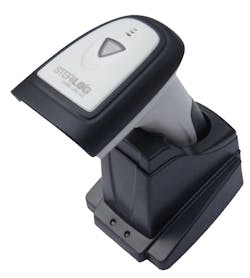A sterilization labeling and logging solution
Before COVID-19 brought the hot-button issues related to contamination, sterilization, and the transfer of bacteria and other pathogens by aerosols from patient to patient or clinician to clinician, there had been a host of issues with dental instrument sterilization.
The HIV/AIDS epidemic that swept the United States in the 1980s and 1990s was a pivotal point for dentistry. The same year that Ronald Reagan signed a presidential executive order creating the first Presidential Commission on AIDS, a woman named Kimberly Bergalis had two molars removed by Dr. David J. Acer.1,2 Later, Bergalis accused Acer of giving her HIV. Dental protocols for sterilization came into question when investigators struggled to figure out how not only Bergalis but five other patients also became infected with the AIDS virus.3
Similarly, in 2013, a Tulsa, Oklahoma-based dentist was accused of unsterile practices that led to a patient contracting hepatitis C.4 In 2019, a medical malpractice lawsuit was filed against a Virginia dental office after the family of a nine-year-old child was treated at the practice with unsterilized instruments.5 In this case, there were at least 50 patients who may have been affected by those unsafe practices. The same year in Seattle, some 1,250 children were treated with instruments that had not been sterilized.6
COVID-19 transmission brought many questions to dental practices regarding the safe processing of dental instruments. Dental providers do not set out to intentionally harm anyone, but clinicians have to be diligent not only in making sure the instruments they use are sterile but also that they have systems in place to test the efficacy of the sterilization equipment. There also must be fail-safes to prove that those systems have, in fact, been adequate in the sterilization process. In dentistry, we must be ahead of the curve, looking for potential hiccups in the system that could affect our patients’ safety and/or the safety of our dental practices’ against threats of litigation.
Thankfully, engineers and designers are always helping clinicians accomplish the task of sterilization more efficiently and effectively. There have been great gains in this area of the dental industry. The first autoclave was invented by Charles Chamberland in 1879,7 with a previous model called a steam digester created by Denis Papin in 1679.8 Instrument sterilization techniques have advanced over the years and created efficiencies for dental practices. Going back to the time when ethylene oxide gas was used to complete a sterilization cycle in 16 hours9 is a time we never want to repeat. The Centers for Disease Control and Prevention (CDC) has set forth many guidelines for sterilization techniques and monitoring device efficacy.10
In Canada, several events involving improper sterilization of dental instruments and monitoring precipitated Public Health Ontario to revise its Infection Prevention and Control (IPAC) checklist for dental practices. The checklist revision was completed and published in July 2019 in collaboration with the Royal College of Dental Surgeons of Ontario (RCDSO), the College of Dental Hygienists of Ontario, and the Ministry of Health and Long-Term Care.11 This checklist for reprocessing dental and /medical equipment/devices is based on Public Health Ontario’s “Best Practices for Cleaning, Disinfection and Sterilization of Medical Equipment/Devices” from May 2013.12 In addition, the RCDSO updated its standards of care for infection control and prevention, which addresses instrument reprocessing, sterilizer monitoring, and other elements of IPAC.13 Interestingly, the regulations in Ontario for dentists do not call for the sterilization package information to be recorded in patients’ charts as they do for hygienists.
In the United States, some states are considering following this protocol. Mandated or not, having proper controls and sterilization records not only will save time in the case of an audit but offer assurance that the sterilization process is being conducted properly. Time is of the essence when adding any new procedure to a dental workflow, and thankfully one company has created a solution that is efficient, cost-effective, automated, and reliable.
SteriLog is a patent-pending automated solution for labeling and logging instrument packages that also allows for certification of indicator test results. According to Dr. Sam Axelrod, vice president and codeveloper of SteriLog, this system meets and exceeds the demands of safety and compliance in instrument reprocessing tracking not only by labeling the packages and completing the logging, but also registering certification of the chemical indicator test results after the sterilization cycle is complete. SteriLog was developed by dental professionals and an IT specialist, and it has been tested in active dental facilities with more than four million packages reprocessed in the last two years.
The cost savings occurs in staff time and the added benefits of increased sterilization accuracy and compliance. The system records the date and maintains a complete automatic data backup that is searchable for specific criteria in the logs. The ability to print out either the entire data log or only selected portions and export to Excel increases efficiency.
The system includes a touch-screen tablet with removable keyboard, SteriLog software, printer, sterilizer-safe labels, thermal transfer ribbon (ink), cables, manuals, Micro SD card, and either a compact stand (figure 2) or wall mount. Setup and operational videos are available, as well as online support. As the regulatory environment changes, SteriLog is committed to updating its system as needed.
All photos courtesy of the author and SteriLog
Editor’s note: This article first appeared in Through the Loupes newsletter, a publication of the Endeavor Business Media Dental Group. Read more articles at this link and subscribe here.
References
- President’s Commission on the HIV epidemic. Wikipedia. Updated March 20, 2020. https://en.wikipedia.org/wiki/President%27s_Commission_on_the_HIV_Epidemic#:~:text=President%20Reagan%20issued%20Executive%20Order%2012601%20creating%20the,of%20the%20Mayo%20Clinic%2C%20to%20chair%20the%20commission
- Kimberly Bergalis. Wikipedia. Updated December 15, 2020. https://en.wikipedia.org/wiki/Kimberly_Bergalis
- Altman LK. AIDS and a dentist’s secrets. New York Times. June 6, 1993. https://www.nytimes.com/1993/06/06/weekinreview/aids-and-a-dentist-s-secrets.html
- Moisse K. 60 Oklahoma dental patients test positive for hepatitis, HIV. ABC News. April 18, 2013. https://abcnews.go.com/Health/60-oklahoma-dental-patients-test-positive-hepatitis-hiv/story?id=18991527
- Lopez T. Malpractice lawsuit filed against Roanoke dentist office. WSLS 10 News. May 10, 2019. https://www.wsls.com/news/2019/05/10/malpractice-lawsuit-filed-against-roanoke-dentist-office/
- Horne D. Students potentially exposed to hepatitis B, C, HIV at 12 school dental clinics. KIRO 7 News. Updated April 2, 2019. https://www.kiro7.com/news/local/students-told-to-get-tested-after-potential-exposure-to-hepatitis-b-c-hiv-at-school-dental-clinics/936425472/
- Charles Chamberland (1851–1908). Translated to English. Pasteur Institute. https://web.archive.org/web/20061219210855/http:/www.pasteur.fr/infosci/archives/chb0.html
- Hugo WB. A brief history of heat, chemical and radiation preservation and disinfection. Int Biodeterior Biodegradation. 1995;36(3-4):197-217. https://doi.org/10.1016/0964-8305(95)00055-0
- Cohen A. Dental sterilization solutions. Objet Geometries Ltd. October 2010. https://www.3dmedicalprint.com/userupload/editorupload/files/files/pdf/Dental_Sterilization.pdf
- COVID-19 Guidance for dental settings. Interim infection prevention and cntrol guidance for dental settings during the coronavirus disease 2019 (COVID-19) pandemic. Centers for Disease Control and Prevention. National Center for Immunization and Respiratory Diseases, Division of Viral Diseases. Updated December 4, 2020. https://www.cdc.gov/coronavirus/2019-ncov/hcp/dental-settings.html
- IPAC checklist for clinical office practice: reprocessing of medical equipment/devices. Toronto, ON: Queen's Printer for Ontario; 2019. https://www.publichealthontario.ca/-/media/documents/C/2019/checklist-ipac-dental-reprocessing.pdf?la=en
- Best practices for cleaning, disinfection and sterilization of medical equipment/devices in all health care settings, 3rd edition. Public Health Ontario. Provincial Infectious Diseases Advisory Committee. May 2013. https://www.publichealthontario.ca/-/media/documents/bp-cleaning-disinfection-sterilization-hcs.pdf?la=en
- Standard of Practice, Infection prevention and control. Royal College of Dental Surgeons of Ontario. November 2018. https://www.rcdso.org/en-ca/rcdso-members/running-your-practice/infection-prevention-and-control
Anne O. Rice, BS, RDH, CDP, FAAOSH, graduated from Wichita State University and then continued her studies to earn a bachelor’s degree in oral health promotion. She is a graduate of the BaleDoneen Preceptorship course for cardiovascular disease prevention for health-care practitioners. After almost 30 years of clinical care, she founded Oral Systemic Seminars and is passionate about educating the community on modifiable risk factors for dementia and its relationship to dentistry. In 2020, Rice became a fellow with the American Academy of Oral Systemic Health as well as a certified dementia practitioner and certified brain longevity specialist with the Alzheimer’s Research and Prevention Foundation. Contact Rice at anneorice.com.
About the Author

Anne O. Rice, BS, RDH, CDP, FAAOSH
Anne O. Rice, BS, RDH, CDP, FAAOSH, founded Oral Systemic Seminars after almost 30 years of clinical practice and is passionate about educating the community on modifiable risk factors for dementia and their relationship to dentistry. Anne is a certified dementia practitioner, a longevity specialist, a fellow with AAOSH, and has consulted for Weill Cornell Alzheimer’s Prevention Clinic, FAU, and Atria Institute. Reach out to Anne at anneorice.com.
Updated April 5, 2024


